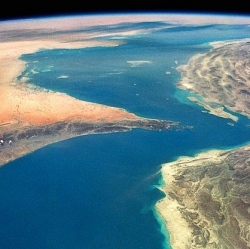
As climate change gets worse, and as no clear path to cutting down emissions in a major way emerges, scientists are increasingly considering ways we could engineer the Earth itself to cool it down. One of these geoengineering ideas is to pump gases into the upper atmosphere.
As we’ve seen after volcanic eruptions, sulfuric gasses like SO4 will marginally shade the Earth by blocking certain segments of incoming light. This sunglasses-effect, if sustained, could help to put the brakes on our planet’s rising temperatures. But according to a new study out today, it also could slow one of the most severe effects of climate change: the increase of severe hurricanes.
Today a multinational team of scientists has published the first compressive breakdown of how sulfates that are dispersed into the Earth’s stratosphere could dampen hurricanes over the next 50 years. Led by John Moore, the head of China’s geoengineering research program, the research group reports that the idea is physically and economically conceivable, and it’d probably work.
In multiple climate models, they found that shading sulfates could cool the ocean’s surface by enough to effectively halve the number of large, Katrina-level hurricanes we’d otherwise see in our warming waters.
The new study focused on modeling two scenarios in which sulfate aerosols are dumped into the stratosphere. In the first, "we’re basically mimicking a volcano and saying we’re going to put 5 billion tons of sulfates a year into the atmosphere 20 kilometers high, and we’ll do that for 50 years," Moore says. These sulfates don’t stay suspended forever. Bit by bit they fall out of the air.
In the second model, the amount of sulfates gradually increases to around 10 billion tons per year after 50 years, to match the global economy’s steadily-growing production of CO2. Both scenarios are based on a widely-used future projection of climate change in which only modest attempts at curtailing CO2 take place.
The scientists found (in their scenario where sulfate injection is doubled over time) that the incidence of Katrina-level hurricanes could be kept at roughly the rate we see today. And when these hurricanes do hit, their most devastating effect to coastal cities, storm surges, would be mitigated by 50 percent.
As the scientists report in their paper, the volcanic eruption of Katmai in Alaska in 1912 "loaded the Northern Hemisphere with aerosol [sulfates], and [was] followed by the least active hurricane season on record."
So how much sulfate exactly is 10 billion tons per year? According to Moore, it’s like mimicking the 1991 Pinatubo volcanic eruption every two years. But while that sounds like a staggering amount, Moore says, "it’s probably the most doable in terms of the geoengineering scenarios we have.
The amount is compatible with our existing airline traffic," he says, noting that fuel-laden sulfates could hypothetically be churned out in airplane exhaust. "And the cost for doing this would be about $10 billion a year. That’s small compared to the cost of attacking our CO2 problem, which is why it’s attractive to a lot of governments as an idea."
But Moore says the global use of shading sulfates is unlikely, and not just because of the cost or the unified effort that would be needed. It turns out that using sulfates to do this would have a devastating unintended effect. A giant dump of sulfates would eat away at the ozone, wreaking long-lasting damage.
"Because of this consequence, no one is really seriously looking at implementing this type of geoengineering project with sulfates, " Moore says. However, he argues, one solution could be to design and produce custom-made aerosol particles, ones which reflect sunlight but don’t have a corrosive ozone effect.
Other geoengineers are already working on designing such particles. Moore argues that his current research, while presently impractical, is still an important to step toward identifying how effective (even devastating) geoengineering approaches would be. Worse case scenario, they could be deployed as emergency stop-gap measure.
"We basically have three options. One’s good, one’s bad, one’s worse. The good option is what we’ve decided not to do. Drastically cut down on CO2 production. The other two options are either business as usual or some geoengineering approach, and we’re trying to figure out which one is the worse option," says Moore. "We pretty much know we won’t use sulfate aerosols, but we shouldn’t dismiss the whole concept while its still in the infancy of research."
